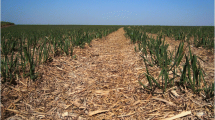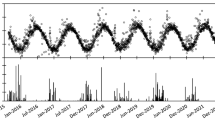Abstract
As a result of climate change, causing high temperature, erratic precipitation, and extreme meteorological events, in recent times in Italy productivity of Maize is becoming less reliable. Climate change effects are accompanied by the increase in the presence of mycotoxins and various pathogens, which contribute to the reduction of the possibility of successfully producing Maize. In this framework, Proso Millet (Panicum miliaceum L.) may be an interesting alternative, as it is a relatively low-demanding crop, highly drought-resistant, and can be employed, similarly to Sorghum, in rotation, maintaining a certain amount of biodiversity and contributing to the revenue for the farmers. Moreover, Proso Millet has a very short cycle, and may be used as a catch crop, when other crops have failed or after their harvest. Millet used to be cultivated in ancient times in Italy, but then it was abandoned in favor of Maize, so now it is necessary to re-define proper agricultural practices and managements, as well as to remedy to the lack of an exact description of its phenological development. In the frame of a Life-CCA EU project, called Growing REsilience AgriculTure—Life (GREAT LIFE), aim of this work is to encode phenology of Proso Millet using BBCH scale. The lack of an exact definition of Proso Millet phenology is a major drawback in progressing in research on this crop, which could be a very valuable tool for improving the resilience of agro-ecosystems to climate change in the Mediterranean basin. For this purpose, Proso Millet was cultivated in two experimental sites in the Emilia-Romagna region (North of Italy). The crop was closely monitored throughout the life cycle, in order to document, even photographically, the achievement of the subsequent phenological phases (including the time necessary to reach each phenological stage, expressed as Days After Sowing—DAS). Thanks to weather data collection from agrometeorological stations close to the experimental fields, it was possible to correlate the phenological development to temperature-driven heat-unit accumulation (Cumulated Growing Degree Days—CGDD), using the single triangle method (useful tool for forecasting purposes). Ancillary agronomic data have also been collected, for completeness. This study well describes primary and secondary phenological stages of Proso Millet, managing at encoding them in the BBCH scale and contextually providing DAS and CGDD values necessary to achieve the different phenophases. The difference observed between the two experimental sites in reaching each BBCH stage according to both CGDD and DAS is mostly restrained, suggesting that this work may represent a valid first tool in defining the phenological development of Proso Millet in the areas of Northern Italy. The effort made to encode Proso Millet phenology in BBCH scale may be useful to give to researchers comprehensive indications for future agronomic surveys on the crop. The agronomic data collected show that the crop had a good agronomic performance despite the adverse weather pattern during the season, enlightening for farmers the opportunity offered by Millet in Italy as a resilient crop.








Similar content being viewed by others
References
Anderson RL (1994) Planting date effect on no-till Proso millet. J Prod Agric 7:454–458. https://doi.org/10.2134/jpa1994.0454
Antolini G, Pavan V, Tomozeiu R, Marletto V, (2017) Atlante Climatico dell’Emilia-Romagna 1961-2015. Arpae Servizio IdroMeteo Clima 33
Baltensperger DD (1996) Foxtail and Proso Millet. In: Janick J (ed) Progress in New Crops. ASHS Press, Alexandria, pp 182–190
Baltensperger DD, Lyon DJ, Anderson R, Holman T, Stymieste C, Shanahan J et al (1995) EC95–137 producing and marketing Proso millet in the High Plains. University of Nebraska-Lincoln Extension, Lincoln, p 709
Ben Hamouda G, Pavan V, Antolini G, Botarelli L, Ventura F (2019) Comparison and validation of daily meteorological data from ERA5 reanalysis with observational surface data, for the Emilia-Romagna region. Proceedings of the XXII National Congress of Agrometeorology, Bologna, Università di Bologna, AlmaDL, 2019, 101–105. https://doi.org/10.6092/unibo/amsacta/6341
Cardenas A, Nelson L, Neild R (1983) Phenological stages of Proso millet. MP45. Univ. Nebraska, Lincoln
Ceccarelli S, Grando S (1996) Drought as a challenge for the plant breeder. Plant Growth Regul 20:149–155. https://doi.org/10.1007/BF00024011
Copernicus Climate Change Service (C3S) (2017): ERA5: Fifth generation of ECMWF atmospheric reanalyses of the global climate. Copernicus Climate Change Service Climate Data Store (CDS), last access 03/15/2019, https://cds.climate.copernicus.eu/cdsapp#!/home
Enciclopedia Agraria Italiana - Ramo editoriale degli agricoltori - Roma, 1972. Vol VII, pp. 643–645
Habiyaremye C, Matanguihan JB, D’Alpoim Guedes J, Ganjyal GM, Whiteman MR, Kidwell KK, Murphy KM (2017) Proso millet (Panicum miliaceum L.) and its potential for cultivation in the Pacific northwest, U.S.: a review. Front Plant Sci 7:1961. https://doi.org/10.3389/fpls.2016.01961
Hulse JH, Laing EM, Pearson OE (1980) Sorghum and the millets: their composition and nutritive value. London Academic Press, pp 187–193
Matzneller P, Ventura F, Gaspari N, Rossi Pisa P (2010) Analysis of climatic trends in data from the agrometeorological station of Bologna-Cadriano, Italy (1952–2007). Clim Chang 100(3–4):717–731. https://doi.org/10.1007/s10584-009-9686-z
Meier U (1997) BBCH-Monograph. Growth stages of plants – Entwicklungsstadien von Pflanzen – Estadios de las plantas – Developpement des plantes. Berlin, Wien: Blackwell, Wissenschaftsverlag. p. 622
Pathak HC (2013) Role of millets in nutritional security of India. New Delhi, National Academy of Agricultural Sciences, pp 1–16
Pellizzaro G, Spano D, Canu A, Cesaraccio C (1996) Calcolo dei gradi-giorno per la previsione delle fasi fenologiche nell’actinidia. Italus Hortus 5:24–30
Rodriguez JB, Westfall DG, Peterson GA (1990) Dry matter and nutrient accumulation and partitioning by Proso Millet. Agron J 82:183–189. https://doi.org/10.2134/agronj1990.00021962008200020003x
Shayegan M, Mazaheri D, Rahimian Mashhad H, Peyghambari SA (2008) Date of planting and mixed cropping of maize (Zea mays L.) and fox-tail millet (setaria italiclica L.) on grain yield and weed control. Iranian J. Crop Sci 10(1):31–46
Snyder R, Spano D, Cesaraccio C, Duce P (1999) Determining degree-day thresholds from field observations. Int J Biometeorol 42:177–182. https://doi.org/10.1007/s004840050102
Tafuri MA, Craig OE, Canci A (2009) Stable isotope evidence for the consumption of millet and other plants in bronze age Italy. Am J Phys Anthropol 139:146–153. https://doi.org/10.1002/ajpa.20955
Theisen AA, Knox EG, Mann FL (1978). Feasibility of introducing food crops better adapted to environmental stress. Vol. II. p. 168-172. Individual Crop Reports. National Sci. Found
Wolkovich EM, Ettinger AK (2014) Back to the future for plant phenology research. New Phyt 203:1021–1024. https://doi.org/10.1111/nph.12957
Zalom FG, Goodell PB, Wilson LT, Barnett WW, Bentley WJ (1983). Degree-days: the calculation and use of heat units in pest management. University of California DANR Leaflet 21373
Acknowledgments
This work was financed in the frame of a Life-CCA EU project, called Growing REsilience AgriculTure—Life (GREAT LIFE), LIFE17 CCA/IT/000067.
Author information
Authors and Affiliations
Corresponding author
Additional information
Publisher’s note
Springer Nature remains neutral with regard to jurisdictional claims in published maps and institutional affiliations.
Rights and permissions
About this article
Cite this article
Ventura, F., Vignudelli, M., Poggi, G.M. et al. Phenological stages of Proso millet (Panicum miliaceum L.) encoded in BBCH scale. Int J Biometeorol 64, 1167–1181 (2020). https://doi.org/10.1007/s00484-020-01891-3
Received:
Revised:
Accepted:
Published:
Issue Date:
DOI: https://doi.org/10.1007/s00484-020-01891-3




